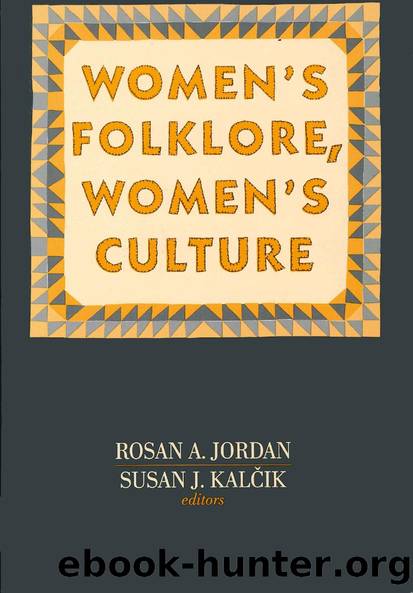Women's Folklore, Women's Culture by Rosan A. Jordan Susan J. Kalcik

Author:Rosan A. Jordan, Susan J. Kalcik [Rosan A. Jordan, Susan J. Kalcik]
Language: eng
Format: epub
ISBN: 9780812212068
Barnesnoble:
Publisher: University of Pennsylvania Press, Inc.
Published: 1985-03-01T00:00:00+00:00
TRICKSTER
The narratives discussed in the preceding section capture the image âMonsterâ so that concepts of order are outlined differentially for a significant number of La Porte residents according to their sex and age; narratives about the murderessâs possible escape from her farmhouse fire, however, cast her in the role of âTrickster,â with subsequent realignments of the order/disorder problem. Although the county coroner officially determined that the body of the decapitated woman found in the ruins of the Gunness home was that of the murderess,10 some official opinions and most unofficial opinions to the present day have it that Belle substituted another womanâs body for her own, set the fire, and absconded with the wealth acquired from the unfortunate suitors she first bilked and then murdered.
The âBelle Gunness is alive and wellâ tradition ranges from simple belief statements, such as the terse âShe got away,â to detailed accounts of her flight which place the murderess in that legend category of famous or infamous characters who live on and on (motifs A570, Culture Hero Lives, and A580, Return of the Culture Hero). The number of La Porte residentsâ personal experience narratives about encounters with the murderess after her supposed death was great enough for a skeptical reporter to headline his newspaper article âThe Mrs. Gunness Very Numerous.â One such subtradition that I have labeled âShamming Sickness in Flightâ deserves attention, for it suggests that the narrators in the sample (both male) define âtricksterâ by correlating it with the stereotype of the woman who manipulates her own âcomplaints and disordersâ so that her position of apparent powerlessness becomes one of power (see Ehrenreich and English 1973).
The first narrator, Jesse L. Hurst, was a cabman for a Decatur, Indiana, line in 1908. Hurst believed that he had seen the murderess bundled up and borne on a stretcher at the train station in Decatur the day after the fire. His account, extant only in the remaining copies of the chapbook The Mrs. Gunness Mystery, published in July 1908, outlines their meeting:
Download
This site does not store any files on its server. We only index and link to content provided by other sites. Please contact the content providers to delete copyright contents if any and email us, we'll remove relevant links or contents immediately.
Cecilia; Or, Memoirs of an Heiress — Volume 1 by Fanny Burney(32083)
Cecilia; Or, Memoirs of an Heiress — Volume 3 by Fanny Burney(31476)
Cecilia; Or, Memoirs of an Heiress — Volume 2 by Fanny Burney(31431)
The Great Music City by Andrea Baker(30888)
We're Going to Need More Wine by Gabrielle Union(18654)
All the Missing Girls by Megan Miranda(14827)
Pimp by Iceberg Slim(13817)
Bombshells: Glamour Girls of a Lifetime by Sullivan Steve(13711)
Fifty Shades Freed by E L James(12933)
Talking to Strangers by Malcolm Gladwell(12909)
Norse Mythology by Gaiman Neil(12875)
For the Love of Europe by Rick Steves(11630)
Crazy Rich Asians by Kevin Kwan(8912)
Mindhunter: Inside the FBI's Elite Serial Crime Unit by John E. Douglas & Mark Olshaker(8742)
The Lost Art of Listening by Michael P. Nichols(7184)
Enlightenment Now: The Case for Reason, Science, Humanism, and Progress by Steven Pinker(6888)
The Four Agreements by Don Miguel Ruiz(6335)
Bad Blood by John Carreyrou(6289)
Weapons of Math Destruction by Cathy O'Neil(5865)
